By Tom Stephens and Nicolas Ruiz
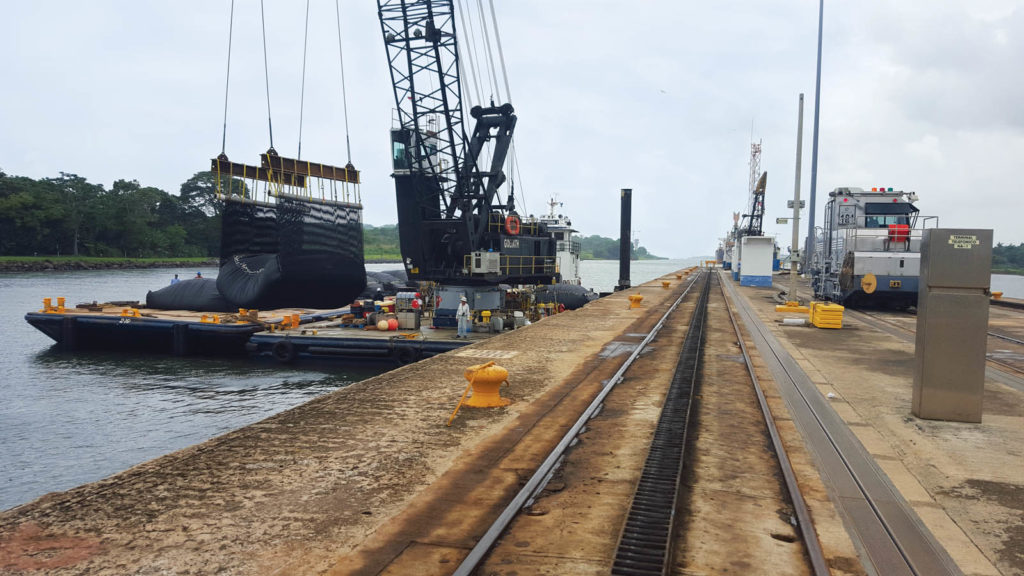
The Panama Canal opened for business 106 years ago and was hailed as the eighth wonder of the world and an engineering marvel. It has become the most consequential global waterway ever constructed. Since 1914, more than a million ships of all sizes have passed through the canal’s original three sets of dual parallel lane locks that are still operating in their original chamber dimensions of 108 feet (33 m) wide × 984 feet (300 m) long × 39 feet (12 m) deep. Today, the canal annually produces $2.5 billion USD in revenue for the Republic of Panama.
The problem
Since 1979, the Panama Canal has been administered and operated by the Autoridad del Canal de Panama (ACP). The ACP Engineering and Maintenance Division has ensured that the canal has been continually operated under safe conditions with modern upgrades and new technology. However, ships have become larger and the tugs to maneuver them in and out of the locks have become more powerful. Today, 82-foot (25-m) long, 4,400-horsepower tugboats of azimuthal propulsion regularly operate in the Panama Canal. This increase in tug power prop wash combined with the continual flow of water through the canal locks has created scour erosion along and under the entrance dividing-wall foundations and the 7-feet (2-m) thick concrete locks approach slab.
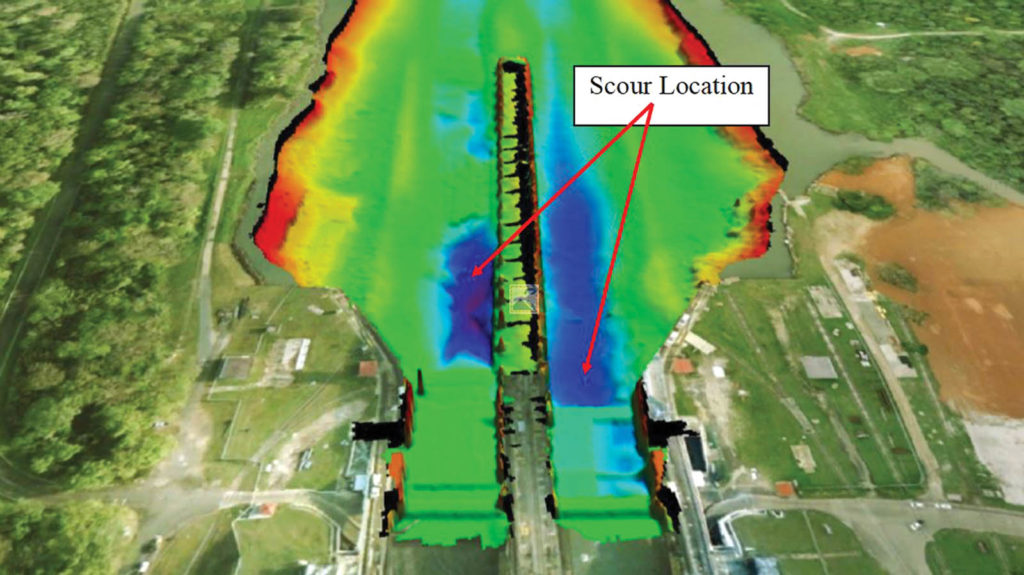
During the December 2014 annual inspection, digital sonar in 66 feet (20 m) of water detected significant erosion and damage to all three sets of locks. However, the Gatun Locks on the Atlantic side were experiencing the most critical erosion and, if steps were not taken to repair the erosion, the locks could be in danger of a catastrophic structural collapse (Figure 2). The erosion had extended more than 20 feet (6 m) under the leading edge of the approach slab and almost completely under the dividing wall foundations. Also, the bases of several wing walls of the other locks were experiencing severe foundation erosion.
The challenge
The ACP engineers determined that immediate action should be taken and that the challenge was threefold: (1) the repair of the damage must not inhibit the flow of traffic through the canal, (2) the repairs must be done during routine maintenance scheduling windows when one side of the locks was temporarily shut down for a 12-hour maintenance operation, and (3) the repairs must be able to be performed by the ACP Engineering and Maintenance Division due to the time constraints and the emergency nature of the repair.
Given these challenges, it was obvious that the repairs would be performed in water depths of up to 66 feet (20 m) with limited visibility, and there was zero margin for error. Also, all preparations for the repairs would need to be performed at an off-site location and be able to be mobilized and then demobilized in short order to stay within 12-hour maintenance windows.
The solution
The ACP Engineering and Maintenance Division met with the TenCate Geosynthetics Group team to jointly brainstorm solutions that may be incorporated to overcome the project challenges and to make the required repairs that would solve the erosion problems. This team quickly arrived at a potential innovative geosynthetic solution that would meet all the challenges and could be rapidly executed.
The solution called for an underwater cofferdam to be installed adjacent to the base of the concrete structures under which erosion scour was occurring. The cofferdam would be formed using 65-cubic-yard (50-m3) sand-filled geotextile bag containers weighing 99 tons (90 tonnes) (Figure 3). The individual geotextile bag units would be flexible enough to conform to the irregular eroded bottom of the canal, yet they would be massive enough to withstand the prop wash of the tugs and high velocity of the water flowing out of the canal locks underneath the Panamax-size ships. In addition, the geotextile bag structure would provide a 7-foot (2-m) thick × 16-foot (5-m) wide erosion control mattress along the base of the entry slab and on either side of the canal entry dividing wall. The geotextile bag containers would be prefilled at an off-site location and transferred to the Gatun Locks where a 386-ton (350-tonne) barge-mounted crane would lift and place them to form a 13-foot (4-m) high × 16-foot (5-m) wide × 98-foot (30-m) long cofferdam. Once the cofferdam was constructed, concrete would be pumped behind the cofferdam and underneath the entry slab to fill the eroded void. This two-step process would be performed during successive scheduled 12-hour maintenance windows.
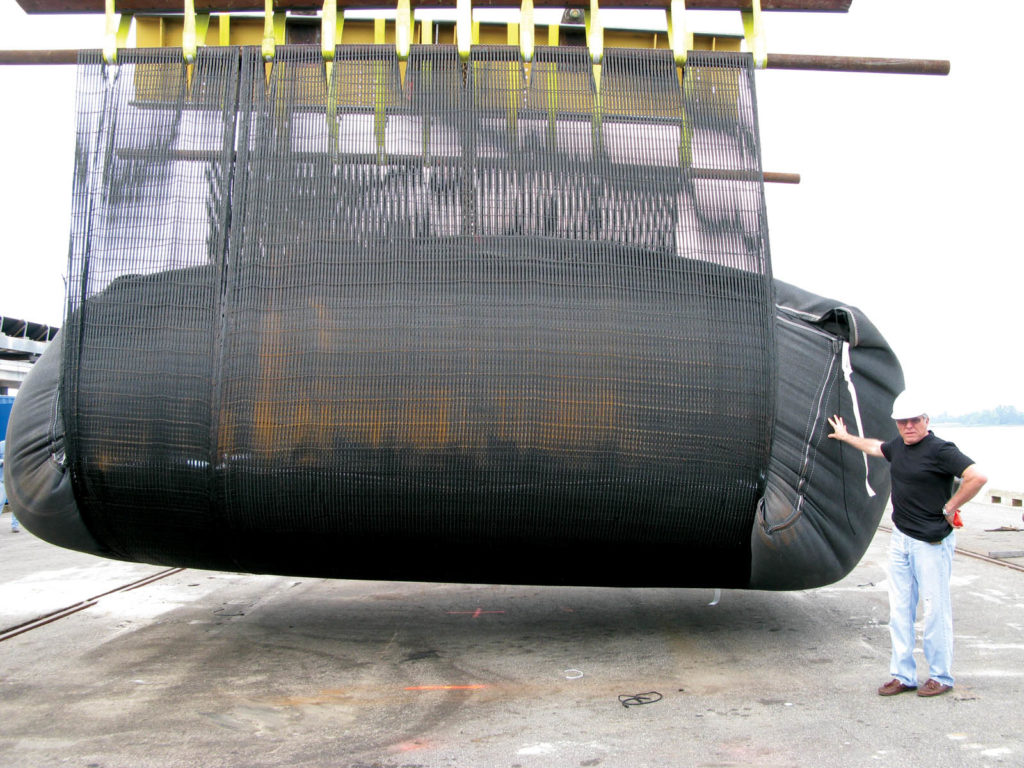
TenCate had previously developed and tested the full-scale system of filling, lifting and placing 65 cubic yards (50 m3) of sand-filled geotextile bag containers, which weighed 99 tons (90 tonnes). The bags were fabricated from a 1,142-pounds-per-inch (200-kN/m) woven polypropylene geotextile in a 16-foot (5-m) wide × 16-foot (5-m) long × 7-foot (2-m) high configuration. The bag had a top lid that was open for filling with sand and could be closed and mechanically sealed to permanently contain the sand. A unique 2,284-pounds-per-inch (400-kN/m) friction geogrid harness was designed and full-scale tested to provide the flexible system of lifting and placing.
The ACP determined that the geotextile bag system provided the required factors of safety and met its criteria to repair the Gatun Locks on the Atlantic side during the 12-hour maintenance window without disrupting the canal operations.
The operation
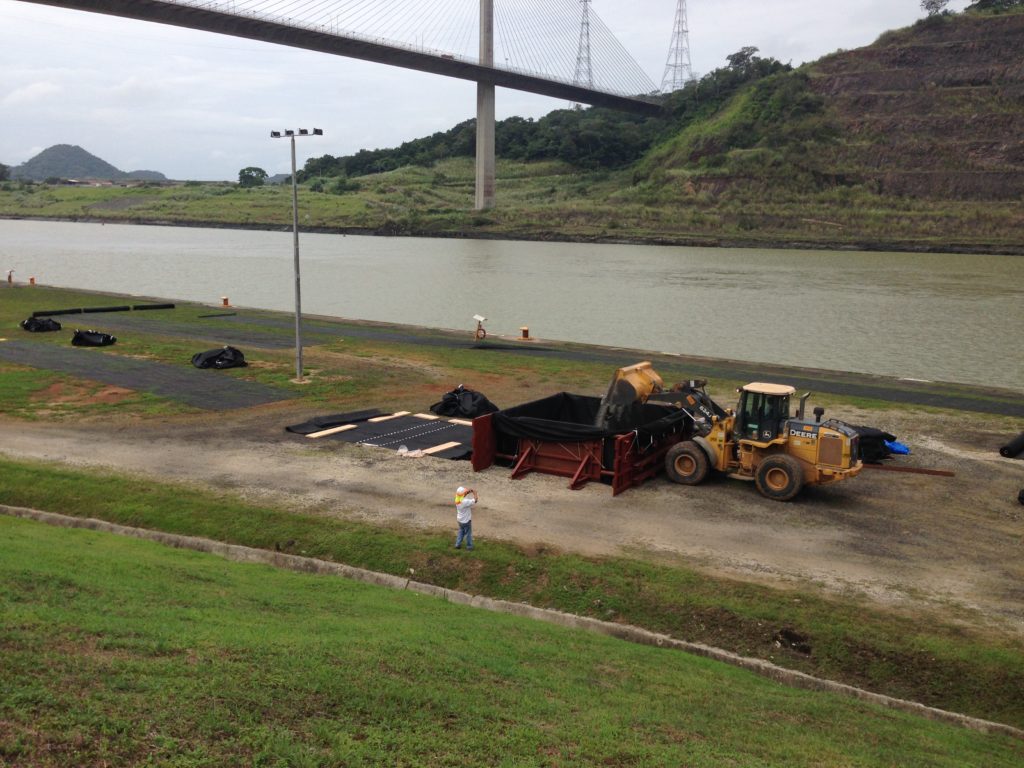
The ACP resolved that the off-site geotextile bag-filling operation would be conducted at its maintenance dock facility adjacent to the canal near the Gaillard Cut, 32 miles (51 km) from the Gatun Locks (Figure 4). The ACP Titan barge-mounted crane lifted the sand-filled 99-ton (90-tonne) geotextile bag containers on to a transfer barge that was moved to the Gatun Locks where crews would be ready to start as soon as the 12-hour maintenance window opened (Figure 5). The first repair was performed on the approach slab to the left chamber of the Atlantic approach to the Gatun Locks.
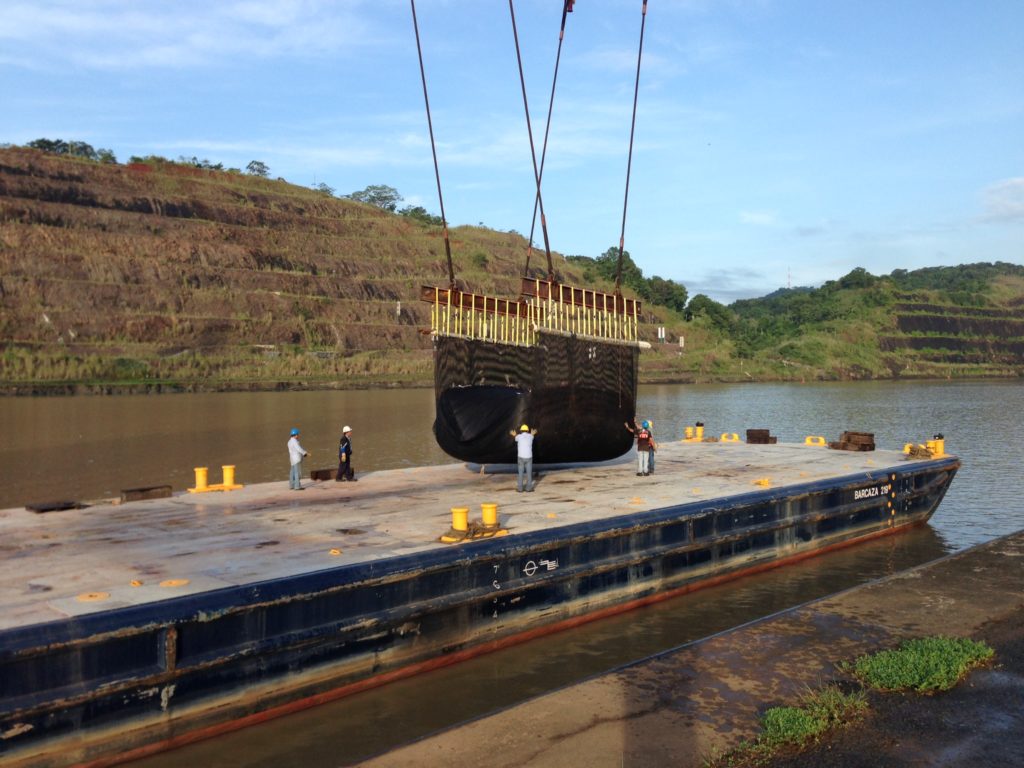
When the repair started, the scour was the entire 110-foot (33.5-m) width of the slab down to a depth of 13 feet (4 m) below the slab and 26 feet (8 m) underneath the slab. This repair would require constructing the cofferdam using 12 of the 65-cubic-yard (50-m3) geotextile bag containers to be installed in the first scheduled 12-hour maintenance window, which was during a nighttime operation (Figure 6). During the next month’s 12-hour nighttime maintenance window, more than 392 cubic yards (300 m3) of concrete was pumped behind the cofferdam and under the approach slab to fill the scour void under the slab (Figure 7).
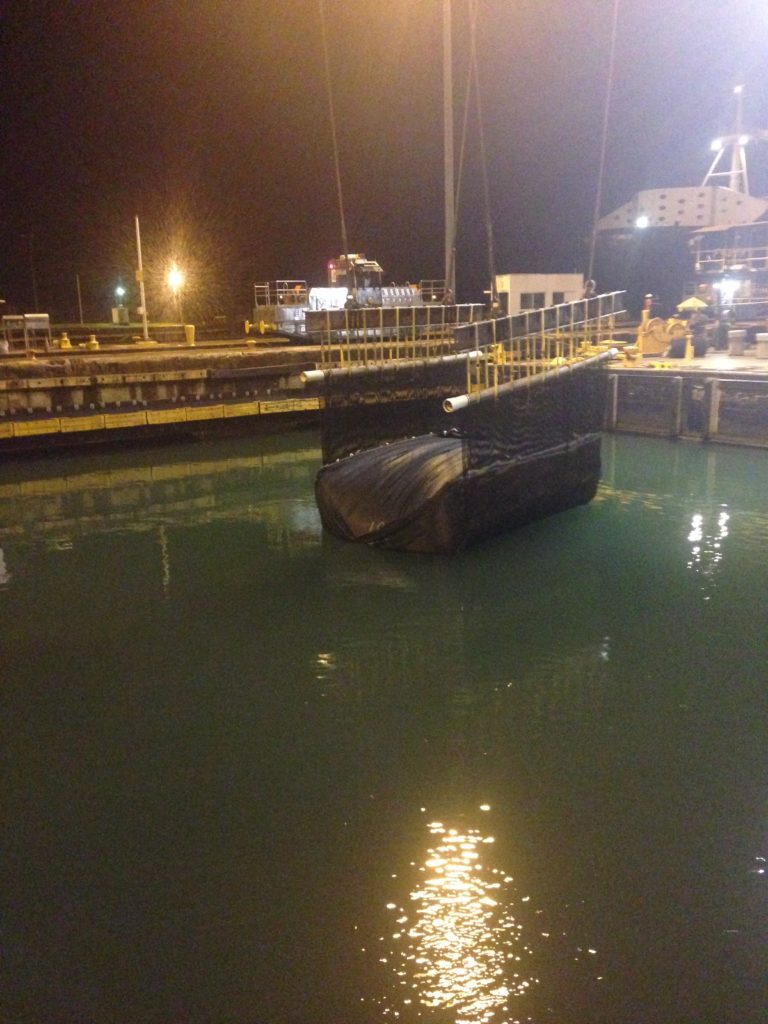
This same procedure was followed to make the scour erosion repair to both sides of the dividing wall in the approach to the Gatun Locks. This methodology has also been followed to perform similar repairs to the Miraflores and Pedro Miguel Locks over the next two years.
The results
There has been no scour erosion detected under any structures of the Panama Canal locks since the repairs using the geotextile bag cofferdam technology started in September 2015. In addition, the ACP has installed more than 400 geotextile bag units to construct underwater cofferdams within the Panama Canal to allow the filling of understructure voids with concrete at other detected scour erosion sites at the Gatun Locks and the other two sets of Panama Canal locks.
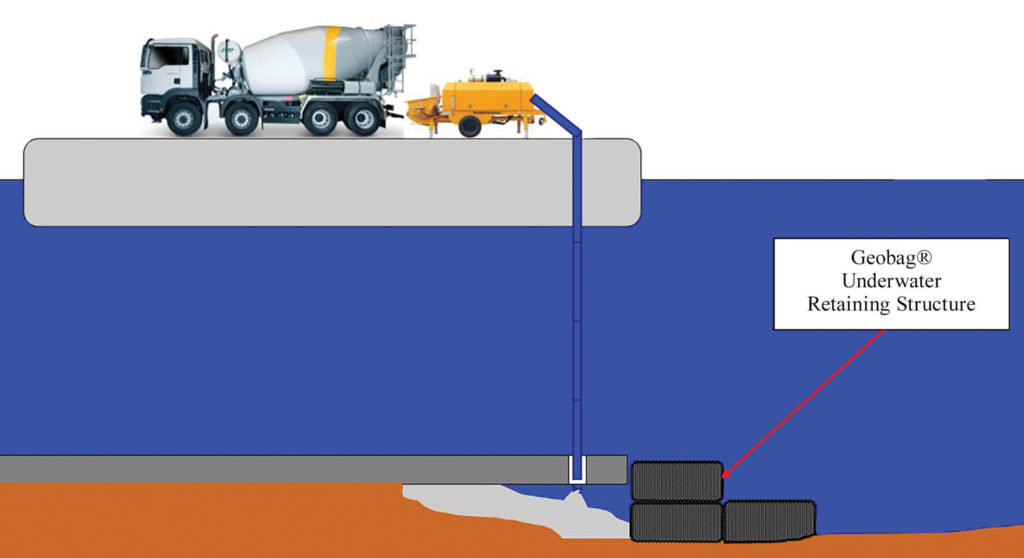
Conclusion
This innovative geotextile bag container/geogrid lifting and placement technology combined with the installation methodology enabled the ACP’s Engineering and Maintenance Division to respond rapidly to a serious threat to the 100-plus-year-old Panama Canal locks that, if not addressed in a timely fashion, could have caused catastrophic damage resulting in both revenue losses and construction costs in the millions to the Panama Canal. In addition, the innovative solution allowed for the required repairs and erosion protection to take place during scheduled maintenance windows without any loss of income for Panama Canal operations. Following the success of this geosynthetic technology in the Panama Canal, the technology was applied to solve severe erosion problems at a major offshore oil terminal located 12 miles (20 km) off the northern coast of Colombia in 100 feet (30.5 m) of water.
Acknowledgments
Special acknowledgment is extended to Antonio Abrego and his team in the ACP’s Engineering and Maintenance Division for their hard work and documentation of the project. Also, Zehong Yuen should be recognized for developing the analysis programs to calculate the factors of safety for the geotextile bag containers and the pullout resistance of the Geogrid Friction Lifting Harness.
This project is dedicated to our colleague, Bruce Lacina, who passed away this past year after a long battle with cancer. Without his technical review and support on our ideas, this project would never have gotten off the ground.
Tom Stephens is director of TenCate Geosynthetics Americas based in Bedford, Va.
Nicolas Ruiz, P.E., M.E., is regional manager of TenCate Geosynthetics Americas based in Commerce, Ga.
Project Highlights
Panama Canal geotextiles and geogrids
OWNER: Autoridad del Canal de Panama (ACP)
LOCATION: Panama
GENERAL CONTRACTOR: Autoridad del Canal de Panama
DESIGN ENGINEER: Eng. Antonio Abrego, Division de Ingeniería ACP
GEOSYNTHETICS PRODUCTS: GT1000M Geotextile/Miragrid 24T Geogrid
GEOSYNTHETICS MANUFACTURER: TenCate Geosynthetics
 TEXTILES.ORG
TEXTILES.ORG


